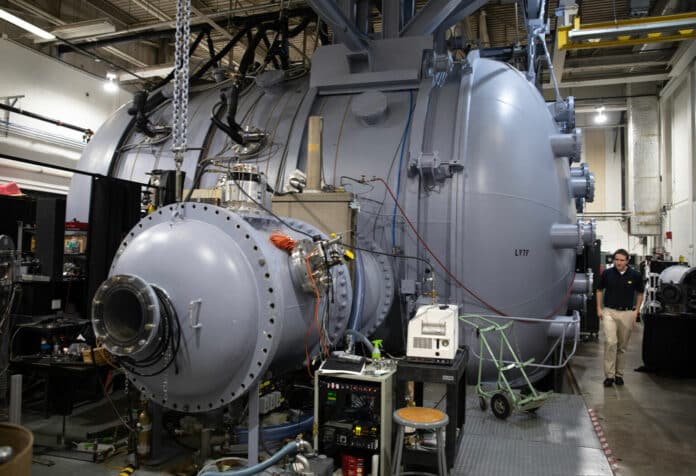Hall-effect thruster (HET) – a type of ion thruster in which the propellant is accelerated by an electric field – has been conventionally used to adjust the orbit of the satellite. But new experiments suggest they could also be scaled up for interplanetary commutes like a crewed mission to Mars.
The belief so far has been that Hall thrusters can’t drive enough propellant atoms at smaller sizes, and getting more power out of them would require a larger Hall thruster, which is too impractical to fit on crewed spacecraft.
“People had previously thought that you could only push a certain amount of current through a thruster area, which in turn translates directly into how much force or thrust you can generate per unit area,” said Benjamin Jorns, U-M associate professor of aerospace engineering who led the new Hall thruster study.
The bottleneck arises from what Jorn calls a “buzz saw” function surrounding the channel that the propellant atoms are driven through. The buzz saw is needed to turn those atoms into positively charged ions that produce thrust.
However, calculations suggested that if a Hall thruster tried to drive more propellant through the engine, the electrons whizzing in a ring would get knocked out of the formation, breaking down that buzz saw function.
“It’s like trying to bite off more than you can chew,” Jorns said. “The buzz saw can’t work its way through that much material.” In addition, the engine would get extremely hot.
Jorns’ team put these beliefs to the test. He and his team simply took the H9 thruster and made a muscle car out of it by scaling it up to a hundred times. They tackled the heat problem by cooling it with water. They found that the xenon-powered H9 MUSCLE ran up to 37.5 kilowatts, with an overall efficiency of about 49%, not far off the 62% efficiency at its design power of 9 kilowatts.
Using the lighter noble gas krypton as a propellant, they maxed out their power supply at 45 kilowatts. At an overall efficiency of 51%, they achieved their maximum thrust of about 1.8 Newtons, on par with the much larger 100-kilowatt-class X3 Hall thruster.
“This is kind of a crazy result because typically, krypton performs a lot worse than xenon on Hall thrusters. So it’s very cool and an interesting path forward to see that we can actually improve krypton’s performance relative to xenon by increasing the thruster current density,” said Leanne Su, a doctoral student in aerospace engineering.
Jorns says that the cooling problem would need a space-worthy solution if Hall thrusters are to run at these high powers. This could enable crewed missions to reach Mars even on the far side of the sun, traveling a distance of 250 million miles. In future plans, researchers hope to pursue the cooling problem as well as challenges in developing both Hall thrusters and magnetoplasmadynamic thrusters on Earth, where few facilities can test Mars-mission-level thrusters.
Journal reference:
- Leanne L. Su, Parker J. Roberts, Tate Gill, William Hurley, Thomas A. Marks, Christopher L. Sercel, Madison Allen, Collin B. Whittaker, Matthew Byrne, Zachariah Brown, Eric Viges and Benjamin Jorns. Operation and Performance of a Magnetically Shielded Hall Thruster at Ultrahigh Current Densities on Xenon and Krypton. DOI: 10.2514/6.2023-0842
